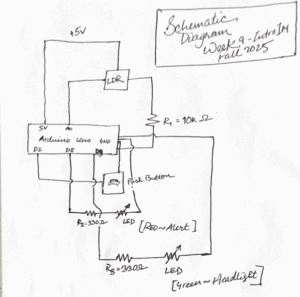Concept
When driving at night, high-beam headlights often blind oncoming drivers. I wanted to explore a simple and affordable system that encourages responsible use of headlights, something that detects oncoming glare and helps the driver automatically or manually switch to low-beam mode. This prototype uses a photoresistor to sense incoming light and a button to simulate the driver’s manual response. Two LEDs represent the vehicle’s headlight (green) and alert indicator (red).
Mechanism
Ambient calibration: when the Arduino starts, it reads the surrounding light for about 1.5 seconds and sets that as a baseline for normal nighttime brightness. This is important in the real world because ambient light differs in places, times.
Glare detection: if the light level rises significantly above that baseline, similar to when another vehicle’s high beams hit, the red LED begins to blink as a warning.
Manual response: when the button is pressed, the green “headlight” LED dims to a predefined low-beam brightness, showing that the driver has dipped the lights.
Return to normal: releasing the button restores full brightness once the road ahead is clear.
Everything happens automatically in a simple loop, using only one analog sensor (photoresistor) and one digital input (button).
Schematic Diagram
Code highlight
The most interesting part for me was sensing ambient light accurately.
I learned how to smooth noisy analog readings using an exponential moving average (
ema = ALPHA * raw + (1 - ALPHA) * ema;
) and how to calibrate a baseline from Arduino documentation and community projects.
This taught me how real-world sensors fluctuate constantly and why filtering is crucial before making decisions based on their data.
Use Cases:
- A bike or e-scooter headlight that adjusts automatically when another vehicle approaches.
- A low-cost training aid for driving schools, showing how to react responsibly to high beams.
- A foundation for smart vehicle lighting projects that aim to reduce glare and improve road safety.
Further Enhancement
1. Replace the LEDs with an actual headlight driver or relay for real-world testing.
2. Use a camera or focused photodiode to distinguish streetlights from oncoming cars.
3. Add automatic dimming without manual input, fully autonomous dipping.
4. Integrate with IoT dashboards to log light data and analyze driving environments.
5. Use a microcontroller with more PWM channels to control multiple lamps independently.
Conclusion
This project started as a simple assignment, but it quickly became a meaningful experiment in safety-oriented design.
By combining analog sensing, human interaction, and basic control logic, I built a small system that mimics how real vehicles manage headlight behavior. It reminded me that even modest hardware, guided by thoughtful logic, can address real-world problems.

